What Is FODMAP Stacking?
Simply put, if you are not paying attention to the AMOUNTS of foods that you eat and the COMBINATION of foods that you eat, then you risk FODMAP stacking.
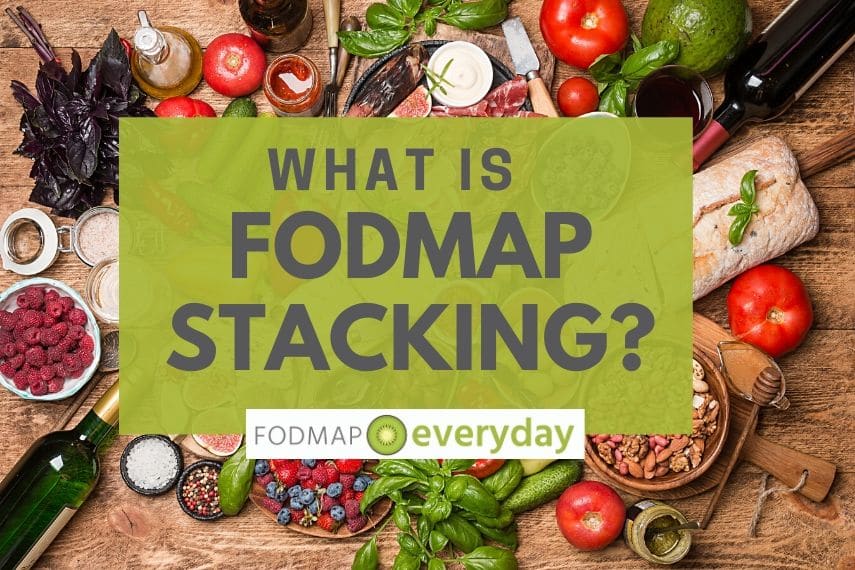
Defined by Monash researchers, “FODMAP stacking is a term referring to how FODMAPs can ‘add up’ in our gut”. In other words, you might ingest a small amount of FODMAPs and not experience any IBS symptoms, but if you eat more of the exact same food(s), and therefore ingest a greater amount of FODMAPs, you might very well develop IBS symptoms.
Portions & Food Combinations Count!
When following the low FODMAP diet we are consuming amounts of foods in their various FODMAP levels, which initially, and broadly, can be determined by using the Monash University Low FODMAP Diet Smartphone App or the FODMAP Friendly App. These two resources will show you what serving sizes of a particular food will be low FODMAP according to lab testing.
Researchers at Monash University and FODMAP Friendly are the originators of the diet and these are the primary resources used by dietitians, doctors and other researchers. Currently, these are the ONLY two entities that are lab testing foods for FODMAPs. Other apps present incorrect and/or incomplete information. Please stick with these apps – and do download them immediately if you have not already.
Monash University presents the traffic light system (Green for Low FODMAP; Yellow for Moderate; Red for High FODMAP) and much of the time will call out which individual FODMAP is involved. FODMAP Friendly has a system which always lists each type of FODMAP, as well as percentages of those FODMAPs, which can be used to assess stacking on a more micro level.
Ultimately the amount that is low FODMAP for YOU will be determined during a structured Challenge Phase, but the apps, which provide lab-tested results for individual foods, are the place to start.
This article on What Is FODMAP Stacking? will explain what you need to know about stacking and why it is important.
Learn About The Different FODMAPS
First, it is important to understand that there are several types of different FODMAPS, which we explain in our article, What Are FODMAPs?
Brush up on Oligosaccharides, Disaccharides, Monosaccharides and Polyols before continuing.
FODMAP Stacking Explained
There are different ways of assessing stacking.
Stacking The Same FODMAP
One way is to look at stacking one kind of FODMAP, let’s say excess fructose (the monosaccharide, or “M” in FODMAP). It is easy to understand how eating too much of the same FODMAP might tip the scales. It is also easy to look up what FODMAPs foods contain in the Monash University and FODMAP Friendly apps.
In the FODMAP Friendly app in particular, they show percentages, which is very helpful. As an example, let’s say you want a snack. Look up blueberries in the FODMAP Friendly app. The entry tells us that at a 1 cup (150 g) serving that the Excess Fructose is at 50% (prior tests said 60%, FYI). A total of 100% would be your maximum amount of fructose to keep the serving size low FODMAP. So, from this entry alone you can see that twice the amount would bring the fructose total to 100%, but any more would make it a high FODMAP serving size.
But let’s stick with the 1 cup (150 g) serving of blueberries for a moment. Now look at Dried Banana chips. At a ½ cup (40 g) serving, the Excess Fructose is only 20%. This means you could eat both the amount of blueberries and the banana chips, and the Excess Fructose would only total 70%, and the combination would be a great low FODMAP snack!
PLEASE NOTE: These numbers are representative of lab tests that were done at a particular time, on a certain mixed batch of berries. The berries you buy today literally cannot be the same; they have an indeterminate amount of FODMAPs. The apps are meant to be be used as guides. In addition, please read our article about how to understand when FODMAPs differ in the two apps, in addition to test batch to test batch.
Stacking Multiple FODMAPs
In late 2022 Monash University made a push for us to look at stacking as eating one or more FODMAP in excess of .5 g per meal. The science backing this up has been around for years, meaning that tests have shown that if one eats less than .5 g total of FODMAPs (excluding lactose) at a meal, it is unlikely that you will trigger IBS symptoms.
However, most lay people have not read the scientific papers, and most importantly, while Monash researchers have written many of those papers, and have raw data available to themselves, they have not shared with the public a way for us to add up foods to determine the .5 g in an exacting way.
This makes things difficult. Our recommendations, which are based upon Monash’s, are as follows:
- There is no need to worry about stacking if your symptoms are controlled.
- If you have been basing your stacking approach on avoiding large amounts of the same FODMAP, and that has worked for you, don’t change a thing.
- If you have breakthrough symptoms and have been having difficulty understanding why, then taking a closer look at stacking would be prudent:
- Make sure to space out meals by about 3 hours.
- Focus on “no FODMAP” foods, those with “trace” amounts of FODMAPs, and foods that have generous Green Light Low FODMAP serving sizes according to the Monash app. This will keep your overall level of FODMAPs lowered.
- Note that Monash designed their system so that you can eat multiple foods at the Green Light Low FODMAP level at once, and remain low FODMAP.
- According to Monash, the collective reduction of all FODMAPs has a greater, positive affect than focusing on reducing one FODMAP.
According to Monash, the collective reduction of all FODMAPs has a greater, positive affect than focusing on reducing one FODMAP.
Notes on “No” & “Trace” FODMAP Foods
A while ago Monash began removing the words “no FODMAPs” and “trace FODMAPs” from the app. They believe they created confusion; we disagree.
The articles linked above t will take you to posts that describe foods that have been lab tested and shown to have “no” FODMAP content, as well as “trace” content. Even if those foods are re-tested in the lab and show higher FODMAP content at a later date, that does not mean the earlier tests were “wrong”. What it tells us is that those foods are capable of containing no FODMAPs, or trace amounts of FODMAPs – or they could have higher FODMAP levels. As the science is evolving Monash and researchers have come to realize that they actually expect fruits and vegetables, in particular, to have varied FODMAP content upon re-testing. There are just too many variables. If you have not read our article, When Low FODMAP Lab Test Results Differ, please pause and do so now.
Lactose Is Considered Separately
The .5 g of total FODMAPs per meal excludes lactose. Luckily, the easiest FODMAP to determine is the disaccharide lactose (the “D” in FODMAP). Clinical tests have shown that if a serving size of a food has less than 1 g of lactose, that it is low FODMAP. Lactose is a sugar. It is easy to find Sugar listed on nutritional panels. See this cheese label below:
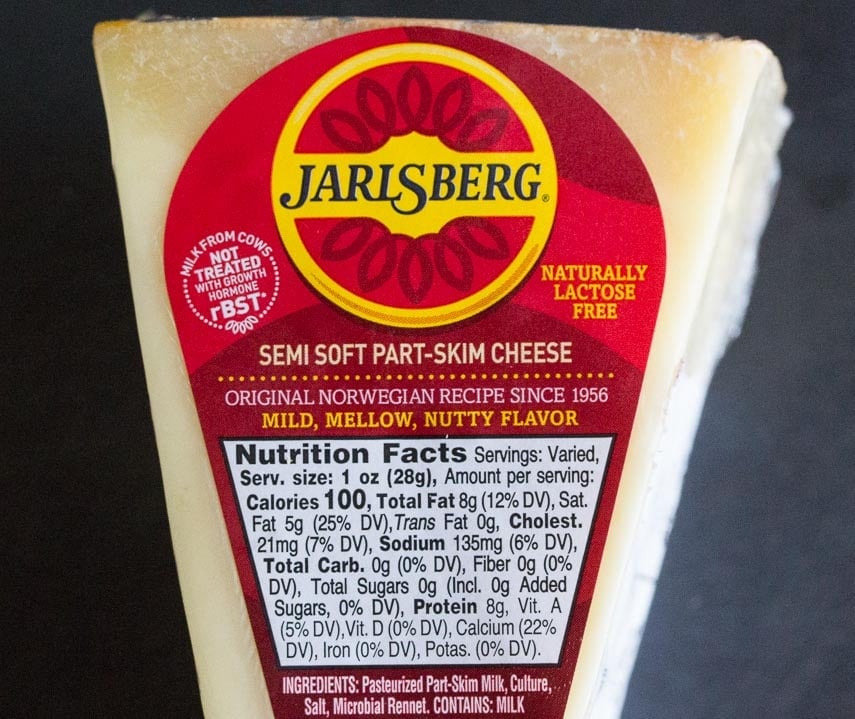
You can see in the image above that the Total Sugars are less than 1 g; this means the serving size of that food is low FODMAP and appropriate even for the Elimination Phase.
Timing is Important
Stacking becomes an issue when too many FODMAPs are consumed at the same meal, or within the same time frame, which is usually considered to be about 3 hours. This is why spacing out your meals is important. Also, note that the amounts of foods listed in the Monash and FODMAP Friendly apps are per meal.
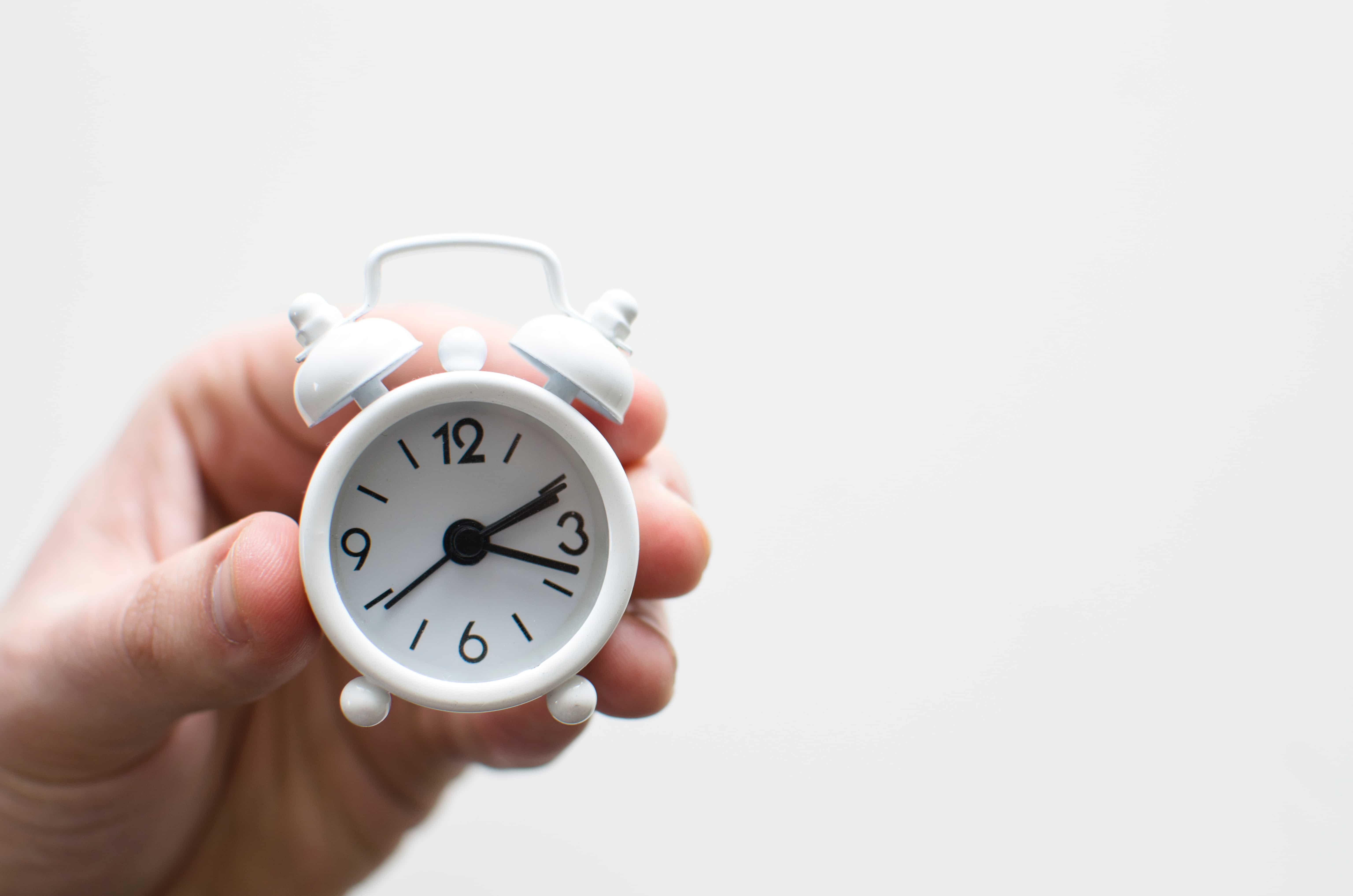
Meals are assumed to be about 3 hours apart.
In theory, you could eat a low FODMAP amount of 10 almonds (24 g) at breakfast, and eat them again later in the day and experience no ill effects. Practically speaking, your experience might vary. The lab tested and reported amounts of foods are a place for you to begin your exploration of your unique relationship to FODMAPs.
If you cannot tolerate a published low FODMAP serving size, it does mean that anything is wrong. This is just your body’s unique, personal reaction. This article will be of interest: What Is A Low FODMAP Serving Size? We are fond of saying, you are not a lab!
Some dietitians also point out that since it can take quite a while for FODMAP symptoms to occur, that stacking could potentially occur within a 24 hour period. You can review a video Webinar lead by the team at Diet vs. Disease for more info.
Please also see our article on Timing of Digestive Symptoms: What It Means.
Individual Tolerance is What Counts Most Of All!
Whether an IBS symptom is triggered is a highly individual issue. Here is where your unique digestive system comes into play.
One person might be able to actually eat 20 almonds (24 g) – DOUBLE the recommended amount – at one time and experience no symptoms.
Another person might only be able to tolerate HALF of the recommended low FODMAP amount and discover that 5 nuts (6 g) is what sits well with them.
And yet another person might learn that 10 almonds (24 g) is fine, but not twice in one day, or even two days in a row.
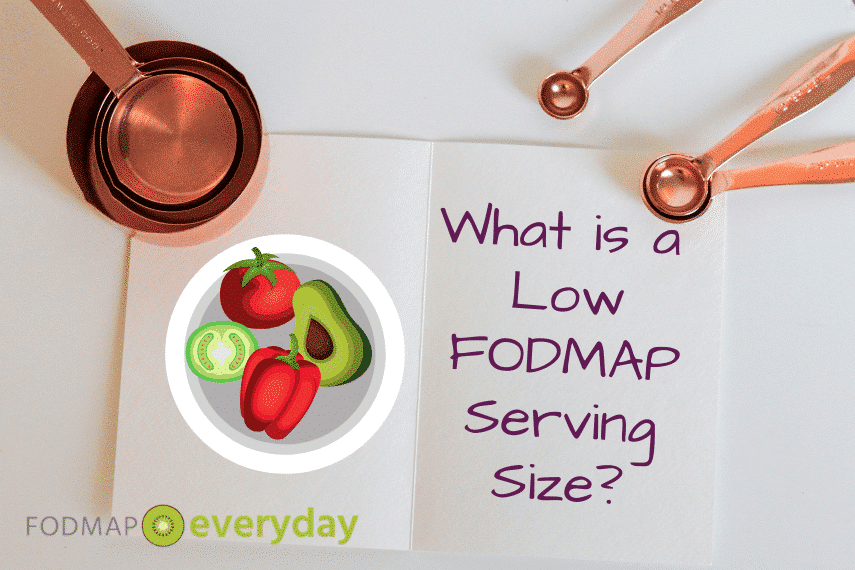
You may want to read: What Is A Low FODMAP Serving Size?
The low FODMAP diet is very nuanced and complex and this is why we always recommend that you undertake the diet along with a registered dietitian to guide you.
The Challenge Phase in particular is best approached with help. We do suggest that you work with a Registered Dietitian (RD) for best results.
You might want to review our articles, Have IBS? Top Reasons To Work With A Dietitian, and also The Role Of The Dietitian vs. The Role Of The Gastroenterologist.
The Takeaway
The low FODMAP diet has many components. There are lab tested prepared foods. There are published amounts of individual FODMAPs in foods. There are meals and recipes that you make in your own kitchens and eat out at restaurants that incorporate multiple foods and stack FODMAPs.
But the most important thing is how you react to FODMAPs yourself and learn to create what we call your own FODMAP Roadmap, that will keep triggers at bay. The best way to accomplish this is to move through the Elimination and Challenge Phases of the diet in a very structured way.
Ultimately it doesn’t matter what any lab testing says; remember, you are not a lab. We will close with a quote from Monash researchers: “It is very difficult to develop specific ‘rules’ about FODMAP stacking as every person with IBS has a varying level of tolerance to different types of FODMAPs.”
“It is very difficult to develop specific ‘rules’ about FODMAP stacking as every person with IBS has a varying level of tolerance to different types of FODMAPs.”
Monash Researchers
Our goal is to provide you with the information that you need to be able to go forth and THRIVE on the low FODMAP diet!
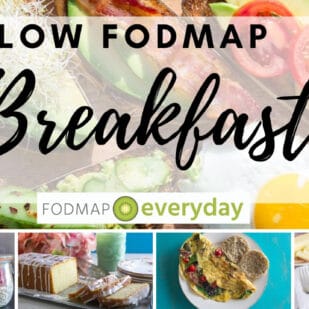






The cooking/recipe competition is a fabulous idea, especially when many people across the world are confined to their homes due to COVID-19. I have just read your article on FODMAP Stacking, which is excellent. Well done FODMAP Everday; keep up the great work 😀
Hi Raelene, Thank you so much for the compliments and feedback – it really means a lot when we hear from individuals. We hope you stay healthy through this challenging time and are able to continue to stay IBS symptom free!
Help.I can’t get through all the ads to get what I need to know.
I have lost so much weight on low fodmap diet I’m down to 90 lbs
I tried eating every 2 hours bur this ended up in bloating and loose stools all over again
I have to gain weight.
Hi Mary, you can set your Browser to hide ads. You have that control; we cannot do that for you. Eating frequently can be a problem for those with IBS. Here is an article on gaining weight, but please consult a Registered Dietitian.
I thought I had IBS, all the symptoms were there. I went on the elimination diet on my own and have not seen much reduction in symptoms. Mainly constipation and weight loss-almost 15 lbs. Not trying to lose weight. Saw a gastro dr who did colonoscopy. DX-diverticulosis. I have heard that the low fodmap diet is being examined for use for other gastro issues like diverticulosis. Have you heard anything about that?
Diverticulosis is definitely one of the screenings that is recommended Before an IBS diagnosis. There is more work to be done in regards to looking at the low FODMAP diet in relation to SIBO and other issues, diverticulosis included. You can read scientific papers, such as THIS ONE, that will shed some light. Your best bet is to work with your specialist and a really good RD, both of whom can tailor an approach to your needs. We have a global RD directory, HERE.
So I know that it’s okay to eat 1/4 cup of chickpeas and 1/2 cup of edamame beans, but can I combine them both in the same meal? According to the Monash app it contains different fodmaps, as far as I can tell/understand?
Yes, you are understanding this correctly. The Chickpeas contain GOS and the Edamame contain fructans, therefore these FODMAPs will not stack, however, they are both Oligosaccharides. And, ultimately, whether the comb o works for you or not can only be determined upon trying. Why not give them a go? If Oligos are a big issue for you, maybe try a smaller amount of both at once first.
If I passed the reintroduction stage of garlic and bread. Would garlic bread be classed as stacking because they’re both fructan?
This is such a great question! Yes, it would be stacking and how you will react no one will know until you try. We would suggest waiting until you are stable and move forward cautiously and maybe try a small amount. Notate your reactions and go from there.
Hi, I am somewhat new to how this low fod map helps control & reduce symptoms.? I couldn’t figure out why sometimes I ate low fod map and STILL had symptoms I think because of stacking. Big difference to know this! So my question is are the recipes designed to avoid stacking?? Or say could you eat 2 servings??
Thanks!
Hi Michelle, good for you for doing your homework! We all have to self-educate with this diet. The serving sizes are set as they are to be low FODMAP, which means we do not recommend eating more. ALSO, since we have no idea how you will use our recipes, we cannot guarantee that if you eat a serving of our meatloaf, and then start adding various side dishes and desserts, that your meal will remain low FODMAP. This is where the self-education comes into play. You might also take a look at our No FODMAP series, which gives you options.
Thanks for this informative article, Dédé. I am finding that most online descriptions of stacking are consistent in saying that the primary cause of problems is combining foods from the same FODMAP category. Your article agrees with the FODMAP Friendly blog (https://fodmapfriendly.com/blogpost/fodmapstacking/), for example. In looking through the resources from Monash University (such as https://www.monashfodmap.com/blog/how-avoid-fodmap-stacking/), I haven’t found such an explicit statement about stacking in relation to foods from the same FODMAP category versus different categories. The matter of combining different FODMAP types in a meal is touched upon in this article (https://www.monashfodmap.com/blog/fodmap-stacking-can-i-overeat-green/), but Monash University doesn’t seem to define stacking as specifically as other sites. Are you able to comment, based on your FODMAP training from that organization? Did the definition of stacking you use in this article (foods containing the same type of FODMAP) originate from Monash University, or elsewhere? Thank you for assisting.
Hi there Melissa, our information is absolutely taken from our Monash dietitian training. I can see what you mean by the articles that they have online that they are not presented quite the way I would expect them to be. There are numerous times that we find that Monash does not help the public understand their information as clearly as they might, and I would put this topic in that category. In the dietitians training it is quite explicit. I’m trying to remember whether it is also explicit in the Patient Training but I’m afraid I do not remember. We have another article specifically geared towards stacking at the holidays which was call written by a Monash trained RD and you’ll see that the information is the same.
Thanks for confirming your source. It is helpful to know that there is widespread agreement on what FODMAP stacking means.
Any widespread agreement come from the primary sources – which are Monash and FODMAP Friendly.
Hello again, Dédé. Monash University has recently issued a blog article to answer questions and clarify misunderstandings related to FODMAP stacking (https://www.monashfodmap.com/blog/fodmap-stacking-explained/). Thankfully, the new post is an improvement upon the ones we discussed above. Most importantly from my perspective, the Monash group now states explicitly:
“Stacking refers to the consumption of foods with any type of FODMAP, not just the consumption of only the same type of FODMAP.”
I am glad to see the former ambiguity resolved. The FODMAP Everyday description, “FODMAP stacking is when you consume two or more foods in low FODMAP portions at the same time and the foods contain the same FODMAP(s),” is no longer consistent with the Monash University position. Do you intend to revise your article accordingly? Thanks in advance for any additional comments you may have.
Hi there Melissa, any changes to our content, is predicated on having some conversations with Monash first. Things are not as simple as they might seem. First of all, the concept that a total amount of .5 g FODMAPs consumed at any given time to be considered low FODMAP has been around for years, as we can see from the clinical studies that were done in 2014.
Our dietitians and I have been working on a response and some questions for Monash, because there’s more than meets the eye. First of all, Monash is good night coming out with this quite expensive book that has notations telling you which recipes can be combined in one meal to remain low FODMAP, but they are not releasing the science that helps one apply this to one’s own food and recipes at home. Not happy about that.
Then there’s the fact that they are still selling materials to dietitians and lay people that show lab test results for all kinds of fruits and vegetables (and other foods) from lab tests that were done many, many years ago. In other words, strawberries and grapes and red peppers are still showing as no FODMAP content. I just ordered some a few weeks ago to confirm this. (This might outrage some; to me it supports what we have always said, which is that FODMAP content of foods, especially produce is hugely variable no matter what. The grapes you buy today are Not the same as they tested, then or recently).
In addition to this we all know that it can take up to 10 hours for something you ingest to trigger IBS symptoms, so therefore we want questions answered about meals being spaced out by 2 to 3 hours. One look at the math and you realize that if you develop IBS symptoms and you’ve already had two or three meals, and a snack or two during the day that you’re not going to be able to trace back what triggered the symptoms. Stacking abounds.
All this together means I will not be making any updates until we have some discussions with the Monash team. At the same time, it really shouldn’t be a source of worry, as all of us have our individual reactions to FODMAPs and any of the lab tests and recommendations, old or new, from Monash or FODMAP Friendly are a perfectly suitable place to begin one’s FODMAP exploration.
And to address your statement, we do not think ambiguity has been resolved at all. Many of our RDs believe things are more confusing
I was just recently informed that one of my girls has IBS. She’s 7, so it’s been quite a process in trying to figure out the things that may be triggers for her. I did a ton of research and found so many mixed results. This is by far the most comprehensive guide to helping me understand why the results are so mixed and it has been incredibly helpful in understanding how to better plan her meals each day. Thank you so much for this information!
Oh Linet! Thank you for writing and we are so thrilled to hear that we are making a difference for your family. It is so tough – and then to be a child, and their caregiver – we know there is a lot to learn and implement. You are doing your research well! Happy to have you hear. PS: If you need access to a RD who specializes in pediatrics, one of our Team members, Julia Celestini, is amazing.